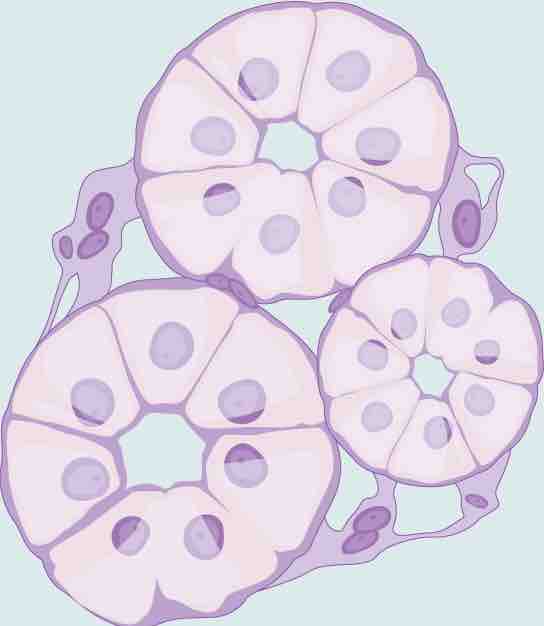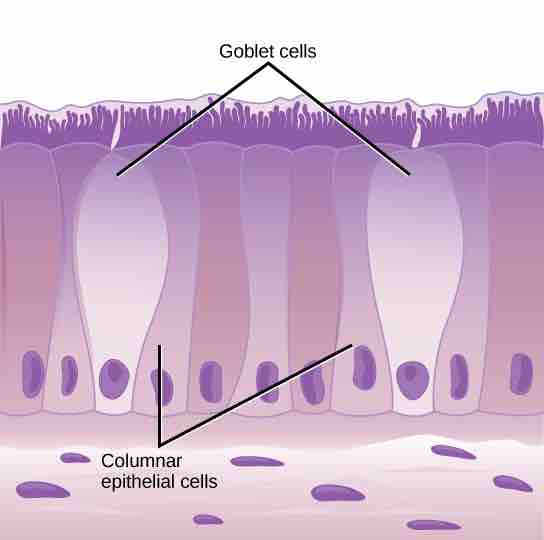Epithelial Tissues
Epithelial tissues cover the outside of organs and structures in the body. They also line the lumens of organs in a single layer or multiple layers of cells. The types of epithelia are classified by the shapes of cells present and the number of layers of cells. Epithelia composed of a single layer of cells is called simple epithelia; epithelial tissue composed of multiple layers is called stratified epithelia.
Types and Shapes of Epithelial Tissues
Squamous Epithelia
Squamous epithelial cells are generally round, flat, and have a small, centrally-located nucleus . The cell outline is slightly irregular; cells fit together to form a covering or lining. When the cells are arranged in a single layer (simple squamous epithelia), they facilitate diffusion in tissues, such as the areas of gas exchange in the lungs or the exchange of nutrients and waste at blood capillaries.

Squamous epithelia
Squamous epithelia cells (a) have a slightly-irregular shape and a small, centrally-located nucleus. These cells can be stratified into layers, as in (b) this human cervix specimen.
Cuboidal Epithelia
Cuboidal epithelial cells are cube-shaped with a single, central nucleus . They are most-commonly found in a single layer, such as a simple epithelia in glandular tissues throughout the body where they prepare and secrete glandular material. They are also found in the walls of tubules and in the ducts of the kidney and liver.

Cuboidal epithelia
Simple cuboidal epithelial cells line tubules in the mammalian kidney where they are involved in filtering the blood.
Columnar Epithelia
Columnar epithelial cells are taller than they are wide: they resemble a stack of columns in an epithelial layer. They are most-commonly found in a single-layer arrangement. The nuclei of columnar epithelial cells in the digestive tract appear to be lined up at the base of the cells . These cells absorb material from the lumen of the digestive tract and prepare it for entry into the body through the circulatory and lymphatic systems.

Columnar epithelia
Simple columnar epithelial cells absorb material from the digestive tract. The nuclei line up at the base of the cells. Goblet cells secret mucous into the digestive tract lumen.
Columnar epithelial cells lining the respiratory tract appear to be stratified. However, each cell is attached to the base membrane of the tissue and, therefore, they are simple tissues. The nuclei are arranged at different levels in the layer of cells, making it appear as though there is more than one layer. This is called pseudostratified, columnar epithelia . This cellular covering has cilia at the apical, or free, surface of the cells. The cilia enhance the movement of mucous and trapped particles out of the respiratory tract, helping to protect the system from invasive microorganisms and harmful material that has been breathed into the body. Goblet cells are interspersed in some tissues (such as the lining of the trachea). The goblet cells contain mucous that traps irritants, which, in the case of the trachea, keep these irritants from getting into the lungs.

Pseudostratified columnar epithelia
Pseudostratified columnar epithelia line the respiratory tract. They exist in one layer, but the arrangement of nuclei at different levels makes it appear that there is more than one layer.
Transitional Epithelia
Transitional (or uroepithelial) cells appear only in the urinary system, primarily in the bladder and ureter. These cells are arranged in a stratified layer, but they have the capability of appearing to pile up on top of each other in a relaxed, empty bladder. As the urinary bladder fills, the epithelial layer unfolds and expands to hold the volume of urine introduced into it; the lining becomes thinner. In other words, the tissue transitions from thick to thin.